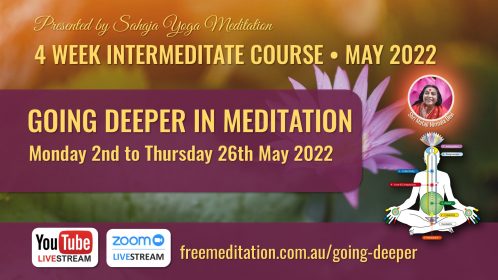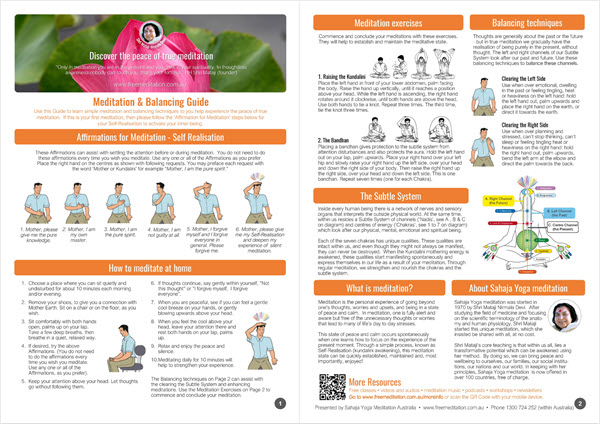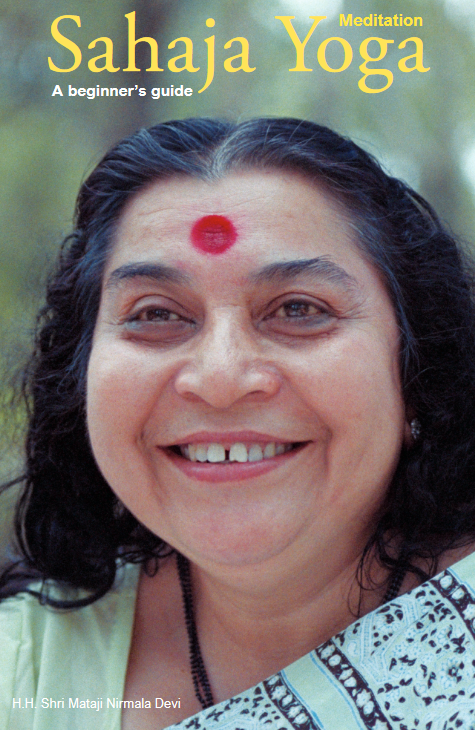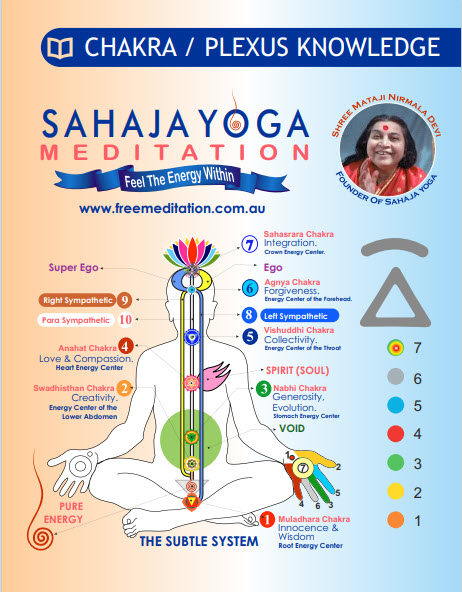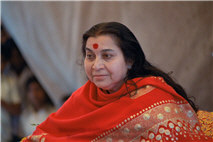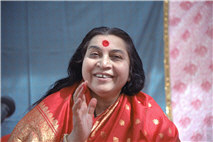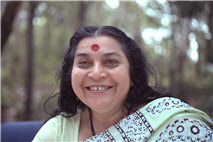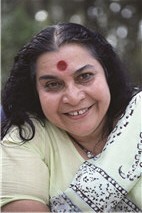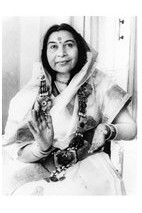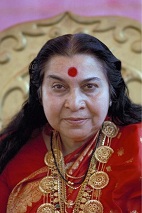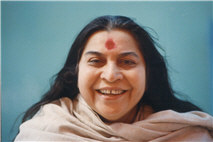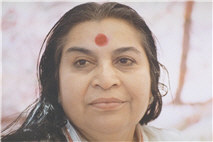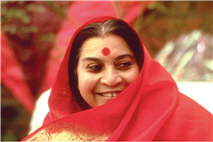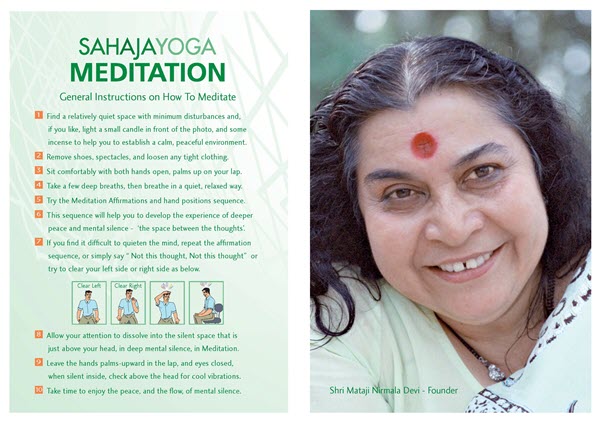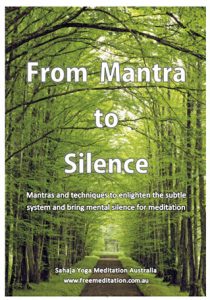Home > Courses > Intermediate Courses – Going Deeper
***This Course has ended***
(Watch the session recordings here)
Please check out our website for our other current classes and courses or contact us.
4 WEEKS INTERMEDIATE COURSE- MAY 2022
Going deeper in meditation
In this series, we continue to develop our meditation practice and go deeper into our being to connect to the Spirit, the pure, immortal part of ourselves where there is only truth, attention and joy.
“As you keep going deeper in the Self-realized state, the darkness keeps getting eliminated in that light.” – Shri Mataji Nirmala Devi 1990
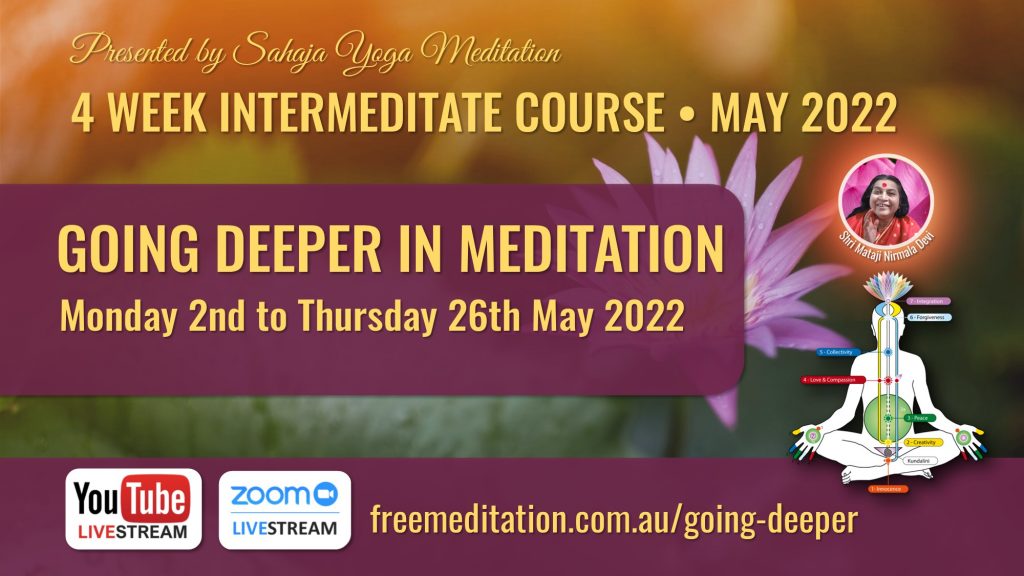
Watch the recordings
This course has now ended. Feel free to check out the recordings below.
This session has ENDED.
“At this time people have to decide what is the most important thing. They have to know themselves and understand what they have got.” Shri Mataji – founder

This session has ENDED.
“This is such a tremendous area you are in – the thousand petals. And from there, people have gained all the knowledge about science, knowledge about all the great discoveries are from there.” Shri Mataji – founder

This session has ENDED.
“You really become part and parcel of each other…. collective consciousness just comes into your central nervous system. .. you have to feel it on your central nervous system.” Shri Mataji – founder

This session has ENDED.
“In Sahasrara, all the chakras are there, so all the Deities get integrated and you can feel their integration. That means, when you get your Kundalini in Sahasrara, your mental, emotional, and your spiritual, everything being becomes one.”

This session has ENDED.
“ I must tell you that it is a desire of God, which is your Mother. And this Mother is your own Mother. You do not have any other Mother but this Mother and She does not have any child but you. Do you think such a Mother who has been waiting to give you this rebirth would be in any way troublesome to you? Even your physical mother bore all the pains upon herself to give you birth. Then why should this Mother try to trouble you?” Shri Mataji 21 April 1980.

This session has ENDED.
“It is the Mother who created the universe; the Father was just a witness to the whole show. It is She works it out the whole thing. It is She makes it beautiful so that He sees the show, that He becomes the spectator, because She loves Her creation.” – Shri Mataji, 16 March 1980

This session has ENDED.
W“The greatest mistake is to close one’s heart. However hurt one may be, remember that within, there is someone who always loves you. She is your individual Mother, your Kundalini”. Shri Mataji – founder

This session has ENDED.
“But I would like to call myself as the Mother. That’s the sweetest and the best I think. Because I am very patient, perhaps and extremely forgiving.” Shri Mataji Nirmala Devi, 1985 As we go deeper into our being through meditation our understanding of who Shri Mataji is changes. Today we explore our connection with Her.

This session has ENDED.
“So, like that, we have seven chakras and the seven notes. And they are different notes but these notes then create permutations and combinations and that is how a chakra gets into a swara (musical note) and then it becomes a sound, and from a sound it becomes a word, and from word it becomes a language and like that it goes on and the same subtle form starts becoming something else.” Shri Mataji 1977-01-26

This session has ENDED.
“Mantras are to be such that they should not be mechanical, just saying something mechanically. You should say it from your heart.” – Shri Mataji, 6 Nov 1983

This session has ENDED.
“But supposing you say a mantra, that’s the sound, with beautiful music and a realised soul then it is very effective….So music, sound, all these things have an effect and we are now using that method very extensively. …” Shri Mataji 1977-01-26

This session has ENDED.
“And there is no mantras written about Sahasrara, so we now have to write Sahasrara mantra” Shri Mataji, 6th May 1990

This session has ENDED.
“Now puja is the left hand side projection. It’s the neutralisation of the right side, very much. Specially for people who are very right handed, atmosphere which is very right handed, puja is ideal for them. Is the bhakti, is the devotion…that you project.” Shri Mataji 1980-07-19 The Meaning Of Puja

This session has ENDED.
W“Puja really is the triggering thing, it triggers you. It triggers you into another realm, it’s really miraculous. Once you have done the puja then you can project out, much more, in your silence only. Your silence itself becomes so powerful.” – Shri Mataji, 19 July 1980

This session has ENDED.
“So by doing the Puja, means when you offer anything that you have got to offer, anything that you offer is – say, flowers, if you want to offer flower to God, you don’t have to speak anything, you have to just offer, that “this is for You.”” Shri Mataji 1982

This session has ENDED.
“What is the meaning of Puja? There is no need to think about it.” Shri Mataji, 26th January 1982

“We are all part and parcel of one country. And that country is of love.” – Shri Mataji (founder)
Register for our other courses
Please register your interest for other Courses so we can keep in touch with you.
Note: You do not need to register to participate in any of our courses.
Resources
Meditation Guides to download, meditative music, video and audio meditations and more resources and materials from this Course are available here.
Some information here is very ‘advanced’, so you should ensure you are regularly meditating so you can appreciate the information. Please don’t hesitate to ask questions about the material during the Course sessions or when you are in contact with one of our mentors.
Welcome to Sahaja Yoga Meditation
“You cannot know the meaning of your life until you are connected to the Power that created you.”
HH Shri Mataji Nirmala Devi – Founder of Sahaja Yoga Meditation
Your Self Realisation
Today, you have been introduced to Sahaja Yoga Meditation and received your Self Realisation. Self-Realisation occurs when the Kundalini, a mothering energy within all of us, is awakened and connects us to the all-pervading power.
Meditation
Through regular meditation, we strengthen our Kundalini to cleanse and balance our energy centres (chakras). Meditation allows us to go beyond our thoughts (thoughtless awareness) to experience inner peace and silence. Regular meditation only takes a few minutes and really works!
Try the meditation
Sit quietly for a few moments and hold out your hands, palms upward, towards the photograph. You may feel a cool or warm breeze and your thoughts may quieten. Continue meditating in silence for 5 to 10 minutes.
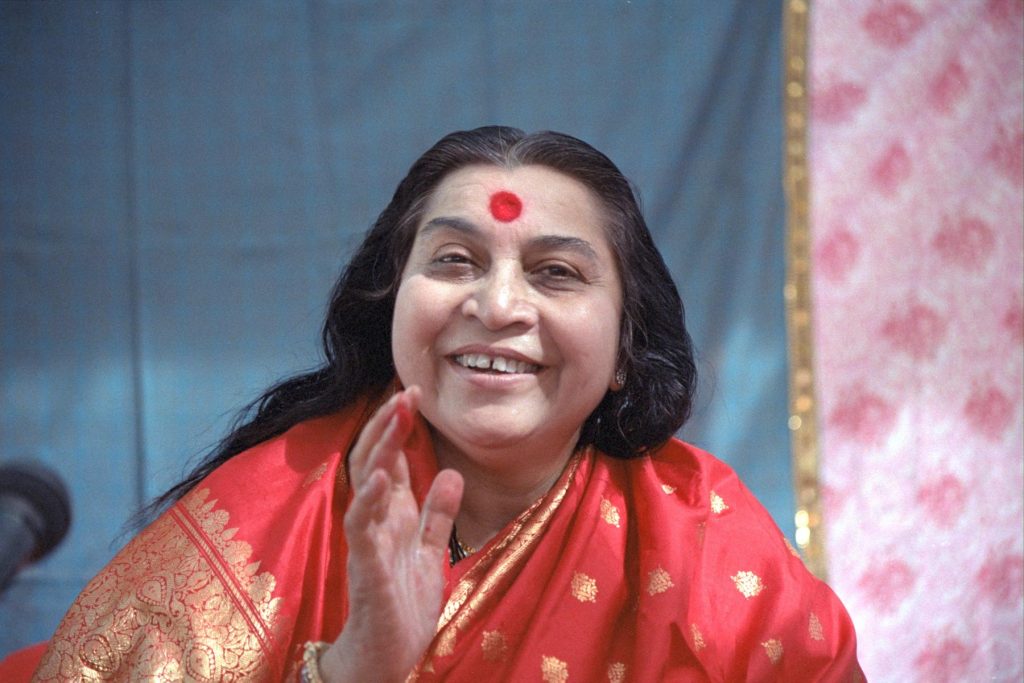
HH Shri Mataji Nirmala Devi
About Sahaja Yoga Meditation
True meditation is a personal experience, where one goes beyond thoughts, worries, and upsets. One is calm and peaceful through ‘thoughtless awareness’- that is, no unwanted thoughts but fully aware. Sahaja Yoga meditation is used by millions globally, with minimal disruption to daily routines, to actually achieve inner balance, joy and improvements in mental, physical, emotional and spiritual well-being.
Sahaja, Saha means ‘with’, Ja means ‘born’. Born with you. That is spontaneous. Yoga means Union with the Divine. So, Sahaja Yoga is the spontaneous union of your Self with the Divine.
Who is Shri Mataji?
Shri Mataji Nirmala Devi (or ‘Mother’, as she is affectionately known) founded Sahaja Yoga meditation in 1970. For over 40 years, she gave thousands of lectures and taught millions around the world how to meditate easily. Born in 1923 in India, she worked with Mahatma Gandhi and was very involved in India’s fight for independence. She was a mother and grandmother and a descendant of an Indian royal family.
The Subtle System
Overlaying our nervous system, resides a subtle system comprising of energy channels (‘Nadis’, see A to C on diagram) and centres of energy (‘Chakras’, see 1 to 7 on diagram). This system looks after our physical, mental, emotional, and spiritual being. Upon ‘Self Realisation’, our spirit is awakened, and the subtle system connects to the all-pervading life force that nourishes and balances it through true meditation.
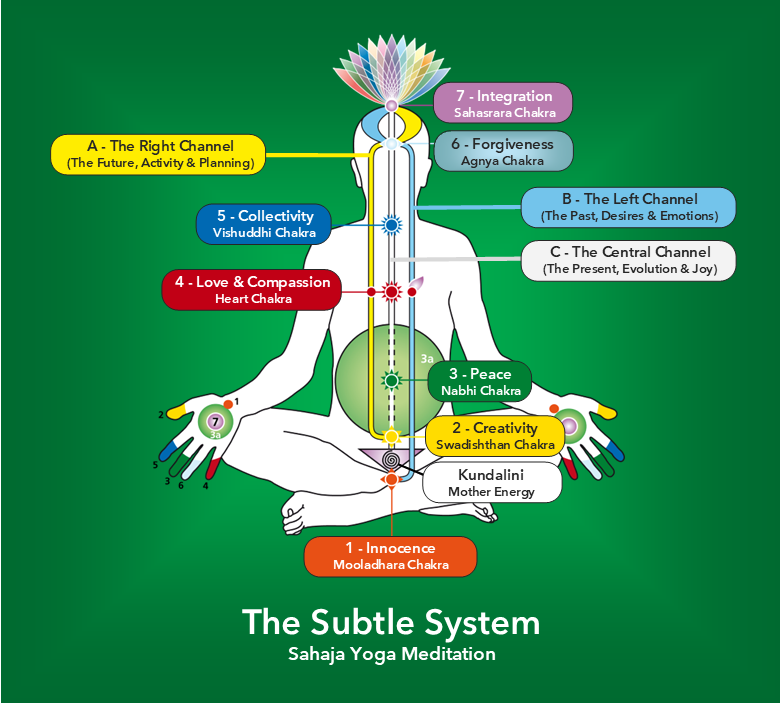
The Subtle System
How do I learn more?
To help you understand this new experience, you are invited to free online courses or weekly classes where collective meditations will establish your Self Realisation. You will learn how to maintain inner balance throughout the day and read and correct any imbalances in your subtle system. Classes are held in over 100 countries worldwide. Suitable for newcomers and regular meditators. No booking needed and everything is provided. Classes are always free of charge.
More Information & Online Resources
Online resources with video and audio meditations, meditative music, balancing techniques, printed guides and talks by Shri Mataji (founder). Live Streaming meditation webcasts. Podcasts with guided meditations, music and talks. Newsletter sign up for news and events.
Use this Guide to learn simple meditation and balancing techniques to help you experience the peace of true meditation. If this is your first meditation, then please follow the ‘Affirmation for Meditation’ steps for your Self-Realisation to activate your inner-being.
- How to Meditate at Home – The aim of every meditation is to feel balanced, relaxed and reach the thoughtless state and sustain yourself there as long as you can. This guide show you steps for your morning and evening meditations.

🌹 SETUP A MEDITATION ALTAR IN YOUR HOME
Materials Required
– Shri Mataji’s photograph in a frame (recommended natural material)
– Candle and candle stand
– A clean pedestal or table for the photograph and candle
Shri Mataji’s photos can be downloaded from here: https://www.freemeditation.com.au/21days/#photos
Having this simple and beautiful setup at your home will not only help you get into the practice of meditation, but will also create a positive balance and energy in your home.
Try it yourself and see the difference…
🌹 USING SHRI MATAJI’S PHOTOGRAPH FOR MEDITATION
We have found that by meditating in front of Shri Mataji’s photographs, our Subtle system comes into balance and is cleared through the positive vibrations that are emitted from her photographs. As result, we become more relaxed and calmer as we experience the inner joy of the Spirit in our heart. We follow the traditional respect and protocol of not placing our feet pointing towards the meditation table and meditate with shoes removed. We can sit on a chair or floor, whichever is the most comfortable.
If you wish to use Shri Mataji’s photograph, then it’s best to place the photo in a frame and use a small candle in front of the photo when meditating. Please contact us if you’d like us to email you other photos of Shri Mataji (in different sizes) for your meditation at [email protected]
The Subtle System
Our Subtle System consists of 3 Channels and 7 main Chakras. The right and left channels are the physical support of our sympathetic nervous system and the central channel is the physical support of our parasympathetic nervous system.
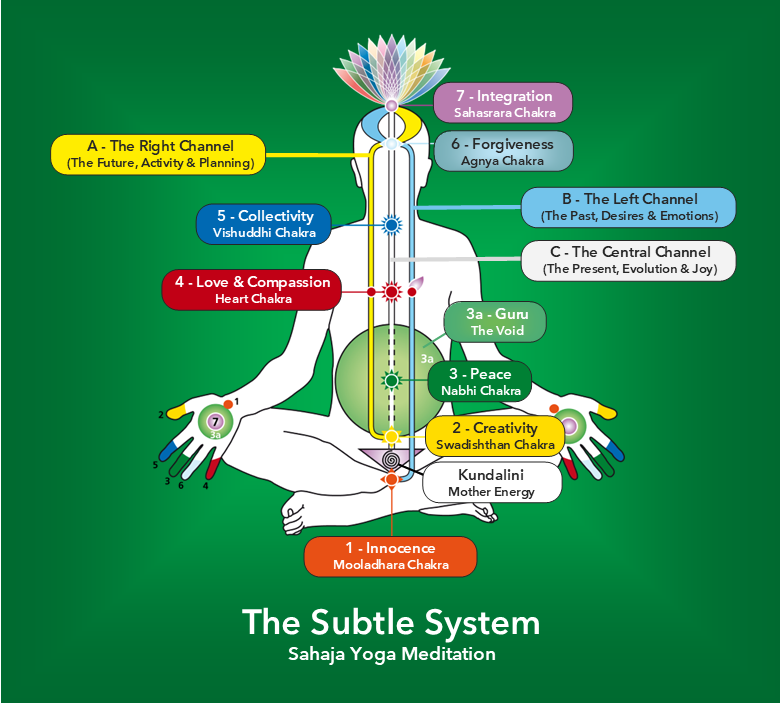
Energy Centres – the Chakras:
1. The Mooladhara Chakra (Innocence)
1a. The Kundalini (Mothering energy)
2. The Swadishthan Chakra (Creativity)
3. The Nabhi Chakra (Peace)
3a. The Void (the Guru principle)
4. The Anahatha Chakra (Love and Compassion)
5. The Vishuddhi Chakra (Collectivity)
6. The Agnya Chakra (Forgiveness)
7. The Sahasrara Chakra (Integration).
Energy Channels – the Nadis:
A. The Right Channel (Physical and mental activity)
B. The Left Channel (Emotions and desires)
C. The Central Channel (Ascent and spiritual growth)
- Our Right channel (yellow line), governs our physical, creative or mental activity. It is the channel of action and the future.
- Our Left channel (blue line), manages our emotions and desires. It is the channel of our past.
- The Central channel (white line), manages our autonomous functions ( heartbeat, etc…). The Kundalini energy rises up the central channel when we receive our Self-Realisation. It is the channel of our spiritual evolution, the Present.
- The Chakras – the Sanskrit word “chakra” means “wheel”. These energy centers or chakras ( numbers 1 to 7 in above diagram) correspond to our main nervous plexuses in the body. Each chakra has its own qualities.
By regular practice of Sahaja Yoga meditation, you obtain the knowledge of your chakras, how to improve and look after them, in a very natural and spontaneous way. Your innate qualities start to manifest themselves. You can feel the state of your subtle system and by using simple techniques, you can maintain it in a balanced state.
We give guidelines of these techniques in our weekly classes in your local area. They are always free. Find free classes in your country.
Self-Realisation
Out of all the energies that sustain us, there is one which is the mother of all other energies. This dormant is of a spiritual nature. It manifests the love that the Divine has for us.
It is called Kundalini and she exists within everyone as a great potential of inner wellbeig. This living energy is waiting to reveal itself to us. Sahaja Yoga meditation starts with the natural awakening of this energy. The spiritual energy that is within us is called Kundalini.
The Kundalini resides in the sacrum bone. This is the triangular bone which is located at the base of the spinal column. When this energy awakens, it activates the central channel and passes through the chakras to come out and can be perceived as a flood, gush, spurt (of coolness) in the fontanelle bone area. Once this energy has been awakened we can perceive its manifestation in a concrete way. A new state of awareness is established within us.
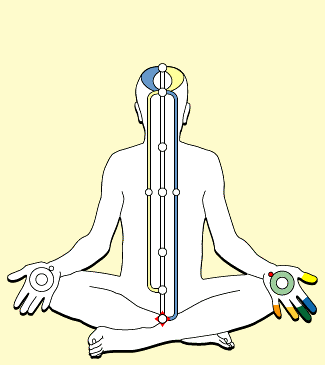
Self-Realisation – the Awakening of the Kundalini mother energy.
As soon as we have felt the condition of our chakras, we can improve them. We have the tools to progress easily with discrimination in our spiritual evolution.
The Kundalini awakening is an indisputable discovery. For the first time, we have the chance to change ourselves and become independent.
Introduction to the three channels of our Subtle System by Shri Mataji.

Videos
Selection of videos about Sahaja Yoga meditation and its many techniques to assist with balancing and clearing the subtle system to ensure peaceful and joy meditations free from thoughts.
Afterwards, Shri Mataji will show you how to raise your own Kundalini and put on a Bandhan, to ...
Self Realisation is the spiritual process of awakening the Kundalini within an individual. Everyone ha...
Shri Mataji guides us on how to do these two important exe...
These exercises will help to establish and maintain a medi...
We hope you enjoy this...
Through meditation, we can surrender to new ideas to overcome these frustrations by going beyond the...
Materials Required
- Shri Mataji's photograph in a frame (recommended natural material)
- Candle and candle stand
- A clean pedestal or table for the photogr...
We invite to our online workshop where you will have the opportunity to interact with an...
How to prepare for the Footsoaking
‘Footsoaking’ is a clearing techniques to bring balance to your inner subtle system and energy centres.
Please have the items below available so you can participate in Footsoaking sessions:
Items required:
- A Footsoak bowl: A plastic or metal bowl for soaking your feet. It should be deep enough so you can put your feet flat in it and cover your ankles, if possible. Fill the Footsoak bowl with cool or warm water.
- Half a cup of table or cooking salt. (Not Epsom salts)
- Jug or bottle of clean water to rinse your feet when finished.
- A towel/cloth or paper towels to dry your feet after rinsing your feet.
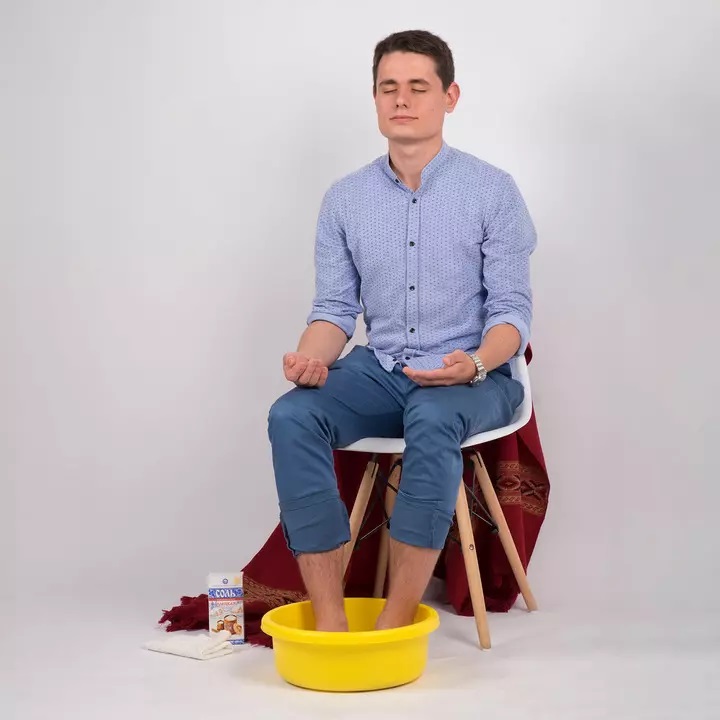
Footsoak treatment
(We’ll show you how to do this treatment during the webcast.)
How to prepare for the Candle Treatment
The Candle treatment is used to clear our ‘left channel’ of imbalances. As a safety precaution, do not do this treatment if you are wearing loose clothes or near any combustible materials. Take great care. You can sit on a chair or the floor for this session.
Please have the items below available so you can participate in the Candle Treatment session:
- A small candle in a holder or secured to a plate.
- Matches/lighter.
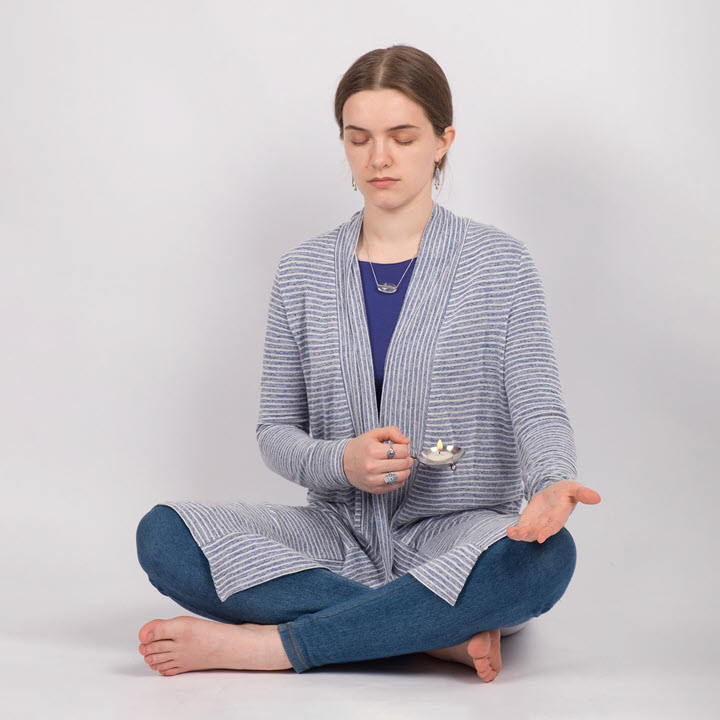 Candle treatment
Candle treatment
(We’ll show you how to do this treatment during the webcast session.)
Music
Ragas/Songs for the Chakras
Selection of Ragas (Songs with mantras) which are a melodic mode of Indian classical music that focus on each chakra of the Subtle System. Listening to the music can help to clear the chakras when meditating.
- Raga for Mooladhara Chakra
- Raga for Swadistan Chakra
- Raga for Nabhi Chakra
- Raga for Void area
- Raga for Left Heart Chakra
- Raga for Center Heart Chakra
- Raga for Vishuddhi Chakra
- Raga for Agnya Chakra
- Raga for Sahastrara Chakra
Meditation music with Didgeridoo instrument.
The didgeridoo is a wind instrument, played with continuously vibrating lips to produce a continuous drone while using a special breathing technique called circular breathing. The didgeridoo was developed by Aboriginal peoples of northern Australia at least 1,500 years ago, and is now in use around the world, though still most strongly associated with Indigenous Australian music.
The Didgeridoo represents the earthy sounds of the Mooladhara chakra which is located at the base of the spine. The chakra has the qualities of innocence and wisdom and manifests in Uluru (Ayers Rock) located in central Australia. The Mooladhara chakra is symbolized by the elephant headed child – Shri Ganesha.
All this music is performed by musicians who practice Sahaja Yoga meditation.
- Omkara Pradhana (Marathi)
- Shri Ganesha Kinaryala Lau (Marathi)
- Invocation To Shri Ganesha
- Tujhacha Mataji Pare
- Namaste Ganapataye
- Ganesha Mantra (Traditional)
Devotional music
Beautiful devotional music in praise of our inner Mother and the external Spirit. Sung by Anandita Basu who is a recognised name in Sahaja music, Sufi and Qawwali music from Kolkata, India. Anandita started to learn Indian Classical music at the age of 4 with her mother and Guru, Professor Anjana Basu.
- Anyatha Sharanam - Thou art my sole refuge
- Sheetal Komal Nirmal - Blessings of the Mother Kundalini,
- Atma Ashtakam - The Light of our Spirit
- Shri Mataji Ke Charano Me - I surrender to my Mother Kundalini
- Shri Durga Chalisa - Giver of Confidence
- O Lal Meri - Oh Lord,my honour
Vishwa Shanthi – Universal Silence
A presentation from the Late P.K. Salve Academy of Music and Fine Arts in India.
Sahaja Yogis from around the world attended the Academy to harness their Self Realisation to learn and develop their artistic skills. While at the academy, they produced this beautiful music that is influenced by western and traditional Indian styles.
- Vishwa Shanthi - Universal Silence - 01 - Universal Silence
- Vishwa Shanthi - Universal Silence - 02 - Calling Out
- Vishwa Shanthi - Universal Silence - 03 - Touching Your Heart
- Vishwa Shanthi - Universal Silence - 04 - Freedom Ride
- Vishwa Shanthi - Universal Silence - 05 - Cada Dia un Poca Mas
- Vishwa Shanthi - Universal Silence - 06 - The Majesty of the King
- Vishwa Shanthi - Universal Silence - 07 - Tidal Wave of Love
- Vishwa Shanthi - Universal Silence - 08 - Vande Mataram
- More meditation music – Selection of music to enhance the meditation experience.
This unique booklet is intended for people who have received their Self Realisation and have commenced daily Sahaja Yoga meditations with regular clearing and balancing.
The booklet provides in-depth information about how to meditate at home, the Subtle System and the clearing and balancing techniques.
Through regular meditation, one is able to fully absorb the divine knowledge contained in this booklet which has been shared with us by Her Holiness Shri Mataji Nirmala Devi – Founder of Sahaja Yoga Meditation.
Download “A Beginner’s Guide to Sahaja Yoga Meditation” (PDF format 11MB size)
Information about the Subtle System, the Chakras and their qualities and characteristics, and where the Chakras are located in the Plexus area of the human body. A plexus is a branching network of vessels or nerves. The vessels may be blood vessels (veins, capillaries) or lymphatic vessels.
The some of chakras are located in these Plexuses areas:
- Pelvic Plexus – Located at the base of our spine.
- Abdominal Aortic Plexus – Located above the Sacrum Bone, in the abdominal region.
- Solar Plexus – Located at the level of the navel.
- Cardiac Plexus – Located at the level of the sternum bone, in the heart region.
- Cervical Plexus – Looks after the Ears, Nose and Throat regions.
Audio and video podcasts
Our podcasts provide listeners with guided meditations, guest speakers, music and more details about the Sahaja Yoga meditation technique. There’s also an opportunity to hear a talk by Shri Mataji (founder).
People tell us how much they enjoy the depth of ‘collective’ meditation when they attend online and weekly classes. But for the times when it’s just not possible to attend, there are podcasts!
Listen to a selection of our podcasts on your mobile device, tablet or desktop.
Audio podcasts
Video podcasts
The Hamsa chakra, which is part of the Vishuddhi and represented by Canada, is situated between the eyebrows, and has the qualities discretion and discrimination; It’s also called the Lambica chakra.
Treatment for the Hamsa is to put a few drops of slightly warm melted purified butter (Ghee) with a dropper into your nose and sniff it up. It avoids dryness of the inner lining. Apply it at night before sleeping.
Affirmation to clear and strengthen the Hamsa is: “Shri Mataji, by Your Grace, please give me the power of discrimination.”
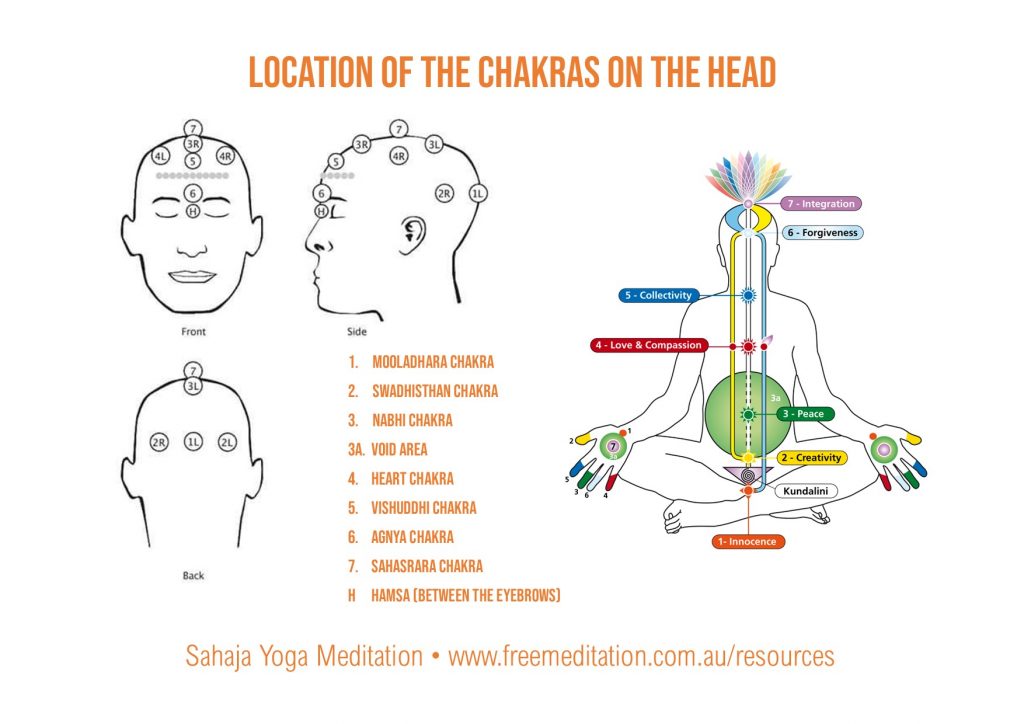
Shri Mataji talks about the Hamsa Chakra

Advise from Shri Mataji about the Hamsa Chakra
“It is, you know, placed between the two eyebrows and two eyes represent the left and the right side. So this centre is very much guided by our eyes, by our ears, by our nose, tongue, teeth, throat. Is a very important centre because the Vishuddhi, which has to look after sixteen petals, which, sixteen petals, which look after all these ear, nose, throat, different, different organs within us, also it has to communicate with the Viraat. So it has to pass through this centre of Hamsa Chakra. Hamsa Chakra is the very pivotal centre, which expresses auspiciousness in our awareness. That means, if this centre is alert and awakened, then we immediately know what is auspicious and what is not auspicious, or we can call it, we get the Divine Discretion… the light of the Spirit, which shines through your Hamsa Chakra, gives you wisdom. Wisdom doesn’t mean that you know how to argue things or you fight with people. No, it doesn’t mean that! Wisdom means how you take to the good side of everything, to enjoy it, this is Wisdom. And that you avoid all destructive things and take to something constructive.” (1992/09/13)
“Now, how can we improve our Hamsa then? It’s a big problem, because if our Hamsa is sick, is over-conditioned. The Kundalini cannot work on it; it just gives up. Now, so for Hamsa we use all these physical things. Like I said, put the ghee in the nose. Keep it in a way that it is nourished properly. Because Kundalini, if it tries to too much attack the Hamsa, it will have a problem. Problem because, as it is most of our time we spend in such a manner that your Hamsa things become – what you call the epithelial cells, the linings – become dried out. When the Kundalini rises, She may try to create a problem more for that dryness – maybe. So it is kept out, but it has an effect in the sense that even if there is a light outside, it can fall inside.”
“So it’s not the Kundalini directly that affects your Hamsa. It is like when the Kundalini awakens, you yourself see now that a person is, whether he is fair complexion or dark complexion, he is a human being. You reason it out and Hamsa clears up. Then you see yourself that, “Oh, I’m very egoistical.” You start seeing yourself through your Agnya, start seeing that, “I’m so conditioned.” So you reason it out, and that’s how you correct your conditionings. This is what is Hamsa chakra.”
Selection of videos by Shri Mataji on her teachings about Sahaja Yoga, Self Realisation, meditations, the subtle system, chakras and other spiritual matters.
Free Meditation Classes available in over 100 countries
https://www.freemeditation.com.a...
Self Realization is the process of awakening the Kundalini within an individual. Everyone ...
Shri Mataji guides us on how to do these two important exe...
1987, Brisbane, Australia.
Place hands on lap (palms up), then...
Mooladhara Chakra: Center of Purity, Wisdom, Inn...
Birmingham Jul 10th 1982
#shrimataji
#shrimataji
“So this is your birthright. All human beings have this right to get the awakening of their Kundalini by which th...
Afterwards, Shri Mataji will show you how to raise your own Kundalini and put on a Bandhan, to ...
Using Shri Mataji’s photograph for meditation
We have found that by meditating in front of Shri Mataji’s photographs, our Subtle system comes into balance and is cleared through the positive vibrations that are emitted from her photographs. As result, we become more relaxed and calmer as we experience the inner joy of the Spirit in our heart. We follow the traditional respect and protocol of not placing our feet pointing towards the meditation table and meditate with shoes removed. We can sit on a chair or floor, whichever is the most comfortable.
If you wish to use Shri Mataji’s photograph, then it’s best to place the photo in a frame and use a small candle in front of the photo when meditating. Please contact us if you’d like us to email you other photos of Shri Mataji (in different sizes) for your meditation at [email protected]
Meditation Photos
All images are in jpg format and are ready for printing. For best print quality, use a high resolution printer or take the files, on a USB stick, to a digital photo lab for printing.
Image sizes available
- 4″ x 6″ (10cm x 15cm) 1800 x 1200 pixels. Average file size for each image is approx 250KBs.
- 6″ x 8″ (15 x 20cm) 2400 x 3200 pixels. Average file size for each image is approx 350KBs.
How to download: To download an image, right-click on the ‘Download’ link and save the file to your computer or device.
Using Shri Mataji’s Photograph
Short video of Shri Mataji explaining why we use her photograph for meditation.
Meditation Card
This Meditation Card contains general instructions on how to meditate with a photo of Shri Mataji and the Affirmations exercise.
“From Mantra to Silence” Booklet
This booklet will help you learn more about the subtle system and how affirmations and mantras can strengthen your meditation experience. Learn how to further enlighten your own inner system; how to identify and clear your subtle blockages; and how to deepen and enjoy the silence of thoughtless awareness.
Free meditation classes and resources to help you discover the unique technique of Sahaja Yoga Meditation.
Resources
- Resources area – Subtle system/chakras, Glossary of Terms, printed guides, meditative music, video and audio meditations, balancing techniques and talks by Shri Mataji (founder).
- More about Sahaja Yoga – What is Meditation? Who can do meditation? What does it cost? Who teaches the meditation? Who teaches the meditation? Getting started.
- More about Shri Mataji – Founder of Sahaja Yoga meditation. Shri Mataji quietly transformed lives. For more than forty years, she travelled internationally, offering free public lectures and the experience of self-realization to all, regardless of race, religion or circumstance.
- Nirmala Vidya Amruta – References to all of Shri Mataji’s talks if you want to look up a particular ailment/issue and find out Shri Mataji’s solutions to it.
- Meditation music – Selection of music to enhance the meditation experience.
- Resources for children – Sahaja Yogi parents who are trying to make meditation for children different and interesting for them. (Password to website is Gananayaka)
- Online daily meditations on YouTube, Facebook and Zoom.
- Audio podcast website – On Apple podcast – On Google podcast.
- Video podcast website – On Apple podcast.
- Sahaja Yogis Experiences – Sahaja Yogis share their experiences, re-collections of memories and encounters with Shri Mataji and the practice of Sahaja Yoga. Find out about Shri Mataji’s life, and enjoy pictures taken over more than three decades in five continents.
- Australian classes – in over 80 locations.
- Worldwide centres – in over 100 countries.
- Subscribe to Newsletter. – To be notified of online events, workshops and other events.
- Contact Us – If you have any questions about our meditation then please don’t hesitate to contact us.
While participating in our sessions, you will come across several terms that may be new to you. This is an overview of the most commonly used terms…
All Pervading Power
God Almighty. Known by many names including Shiva, Allah and Yaweh.
Attention
The faculty of applying the mind and interest. Under pressure it can become short-spanned and undisciplined but through Sahaja Yoga Meditation the faculty can become focused and productive.
Balancing and Clearing
If the attention is majorly focused on right-sided activities (thinking, action, the future) or left side (reflection, emotion, the past) blockages can occur. Meditative clearing removes these blockages and allows the system to gain balance in the centre (mental silence, peace, now).
Catches
Catches occur when the efficient function of chakras is impaired. These catches block the passage of kundalini and are the causes of varying problems. When these damaged charkras are repaired through meditation the problems disappear.
Central Channel
This is the channel through which the kundalini flows. It is opened when self realisation takes place and it is the through-flow of kundalini which brings about real and enriching meditation.
Chakras
These are the subtle energy centres located at the main nerve plexuses along the spine. There are seven main chakras in the human system and they relate to stages of evolution, the seventh, at the top of the head being activated by self realisation.
Cool Breeze
The energy manifested from the top of the head when self realisation takes place. It can be felt as a warmish breeze-like sensation. After meditation the energy cools down and is known as the cool breeze.
Difference between Yoga and Meditation
Yoga is the union of the kundalini with the great energy of creation that surrounds us (self realisation). Meditation takes place as a result of that joining.
Guru
Spiritual teacher, guide. Someone with their self realisation who assists others to gain their yoga.
Kundalini
The mothering energy that resides in the sacrum bone at the base of the spine. When self realisation takes place this energy uncoils, rising through the chakras and the top of the head.
Inner Peace
Being free from mental activity. Not being concerned with memory or plans but being in the ‘now’.
Joy
Happens when deep meditation takes place. A all-embracing sense of relaxed well-being.
Kundalini Awakening
Kundalini resides in three-and-a-half coils at the base of the spine. When self realisation or kundalini awakening takes place, this energy uncoils and rises through the chakras to manifest at the top on the head.
Left Channel
This rises along the left side of the spine but at the forehead it crosses into the right hemisphere of the brain to become the superego. It is concerned with emotion, the past, insecurity, conditioning and, if the attention becomes heavily focused into it, it can cause depression and many painful diseases.
Meditation
It is a state of relaxation without mental activity. It is calming, peaceful and opens the inner pathways to health, knowledge and spiritual deepening.
Right Channel
This rises along the right side of the spine but at the forehead crosses into the left hemisphere of the brain to become the ego. It is concerned with action, the future, planning and, if the attention becomes heavily focused into it, it can cause anger, tensions and many painless diseases.
Sahaja Yoga Meditation
The word ‘Sahaja’ in Sanskrit has two components: ‘Saha’ is ‘with’ and ‘ja’ is ‘born’ – the literal translation is “innate”. Yoga means union with the divine. So, Sahaja Yoga means spontaneous and born with you meaning that the kundalini is born within us and can be awakened spontaneously, without effort. This is Self Realisation
Self Realisation
This is the yoga, the union, the joining of the individual spirit with the great energy of creation. It happens when the kundalini (life force) rises from its home in the sacrum bone along the spine and pierces the fontanelle at the top of the head.
Shri Mataji
The founder of Sahaja Yoga. She was born in 1923 in Chhindwara, India. Her father was a lawyer who spoke fourteen languages and was the first Christian Member of the Indian Parliament. Her mother was the first woman in India to receive an honours degree in mathematics. The family was deeply involved in the Indian fight for independence. Shri Mataji married C.P. Shrivastava, a diplomat who became Secretary General of the UN Maritime Organisation. She has two daughters and four grandchildren. In 1970 she discovered a way of granting spontaneous self realisation. She then travelled the world holding programs, giving self realisation and informing people of Sahaja Yoga.
Spirit
The reflection of divinity within each human subtle energy system.
Spirituality
An intense interest in the non-material aspects of life, reality and existence after death
Subtle System
The network of chakras, channels and kundalini which define the nature of a human being at any given time. (See more here)
Thoughtless Awareness
Is meditation. All thinking stops although the consciousness of sounds around us remains. The traditional name for this very pleasant and rewarding state is mental silence.
Vibrations
The cool pulsing that a realised person feels (often on the palms of the hand) when the attention is focused on something or someone in balance.
Yoga
The pathway to, and gaining of, self realisation. Rajah Yoga is the pathway along the right channel, Bakthi Yoga uses the left channel ‘Sahaja means born-with or spontaneous. So Sahaja Yoga draws attention to the fact that the union (self realisation) can be gained spontaneously by way of mechanisms one is born with.
About Sahaja Yoga meditation
Millions around the world are enjoying our free Sahaja Yoga Meditation since it was started by HH Shri Mataji Nirmala Devi on 5th May,1970. Her meditation enables en-masse Self-Realisation. Self-Realisation is the key to thoughtless awareness, also known as mental silence, and is the basis of good health and wellbeing. Sahaja Yoga meditation provides this experience.
Sahaja Yoga Meditation is always free and is practiced in more than 100 countries.
More details
- Presented by Sahaja Yoga Meditation
- More info contact [email protected]
- Daily meditations on Zoom, Facebook and YouTube.
- Other meditation Courses.
- Centres in 100 countries.

